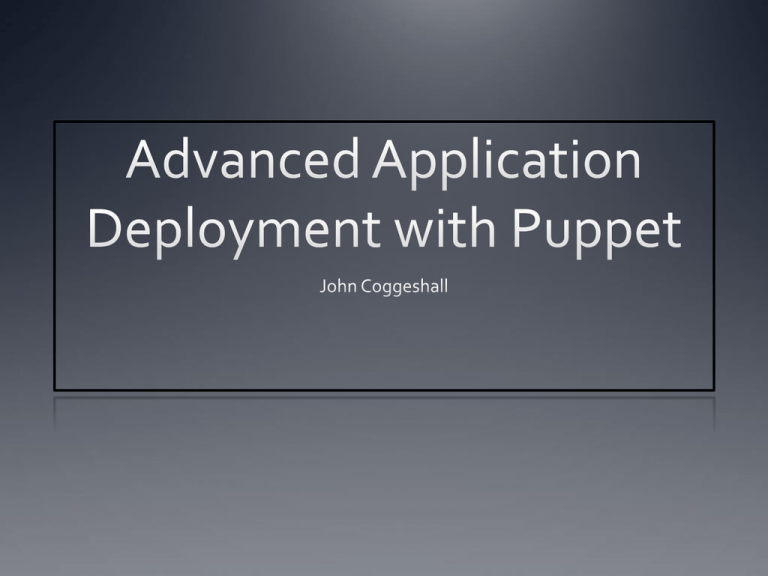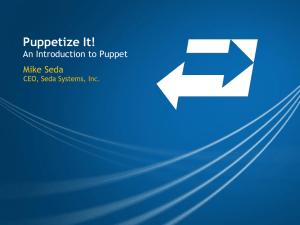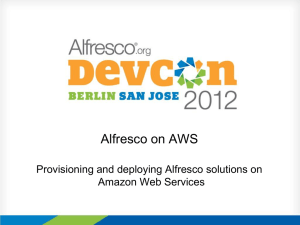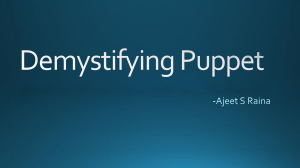Advanced Application Deployment with Puppet
advertisement

About Me CTO, Individual Digital, Inc. (Startup) Author of ext/tidy, PHP 5 Unleashed, Zend Ent. PHP Patterns Twitter: @coogle What’s Puppet? Puppet is … A deployment tool Client/Server Declarative Resource based Puppet is not.. But can leverage Ant Make What makes Puppet cool? Centralized, Scalable configuration management for server farms Abstracted from underlying OS (to a point) Configurations can be stored in a VCS (i.e. Subversion) for historical tracking of changes Automated configuration of individual machines based on configuration Auditing of configuration of individual machines It’s about knowing Puppet helps bridge the gap between system administration and development teams Developers: Virtual machines managed by local Puppet Need new extension? Update Puppet configurations System Admins: System changes are tracked through commits, can be reviewed easily Same Puppet system used as locally Result: Consistent platforms throughout with minimal pain Puppet from 10,000 feet Communication over HTTPS with signed certificates Reporting from clients back to master / Dashboard ability Including Development Same Puppet can run as a stand-alone executable, running off of local checked-out manifests From Zero to Puppet Setup Puppet Master (Kickstart, etc.) Write Puppet Modules (apache module, etc.) Deploy modules to server Setup puppet client with master Process Catalog Installing Puppet (Debian) Installing Puppet is easy: (note: ‘puppetmaster’ package also available stand-alone) For client/server configurations, you’ll also need to sign your client’s certificate Step 1: Attempt to connect to puppet master from client (rejected) Step 2: Use the puppetca tool to sign certificates on master: About Certificates Certificates are very important to puppet, it’s basically the way authentication is performed Puppet does support the ability to auto-sign certificates of new clients Not Recommended – potentially this would allow anyone to sign-in to your puppet master and potentially acquire configuration files, etc. - a big security risk Things you need to know Nodes – A machine being configured, identified generally by its hostname Modules – A collection of classes and files all related to each other Class – A collection of resources related to each other Resources – Things like software packages, files, users, etc. Defines – A function-like construct for resources Resources: Implementation Abstraction Puppet is based on resources Think in terms of a “user”, not the /etc/passwd file Declare what you want done, let puppet worry about how that happens Resource Types (some) Augeas Nagios Computer Package Cron Service Exec SSH Key File User Filebucket VCS Repo Group Zone Host Mailalias More At: http://docs.puppetlabs.com/references/stable/type.html Getting Started Basic idea: The global master manifest is site.pp which typically defines the node types puppet can configure Step 1: Define a node by hostname Step 2: Include / declare any configuration to be done to that node Puppet supports includes and modules, making things a lot easier to organize How I organize puppet You can organize puppet in many ways to suit your needs Can be a bit confusing when getting started How I organize my puppet manifests: Puppet Modules Puppet Modules are designed to encapsulate a logical segment of the machine’s setup Example modules: MongoDb Users Apache Webserver Puppet Modules Modules also have access to a simple file service, allowing you to store entire configuration files within the module then transfer those files to the machine Puppet Module Structure manifests/ declarations files/ hosted files init.pp – processed when module is included How I organize puppet modules Puppet modules have a simple “class” structure I typically create one or more of the following classes for each module: Module::install Module::config Module::service Then, include these modules in the proper order with the base module’s class Every “package” should be a module to avoid dependency problems Example: Custom login message Task: Update the /etc/issue-standard file so it always displays the IP address of the machine when you connect to it Useful for VMs, inconsequential to deployed boxes While we’re at it, put a scary warning up at login What we need to do: Create a /etc/issue-standard we want to use Create a update-prelogin.sh script to determine IP address and update /etc/issue as necessary Install new standard, as well as pre-login script Our update script Creating modules/issue Now we need to create a modules/issue that performs the necessary tasks Step 1: Create issues/files/update-prelogin.sh Step 2: Create init.pp Step 3: Profit modules/issue/init.pp Using our module To use our new module for a specific node type, simply include it in the node declaration of site.pp: Inheritance works great too: Dependencies, Notifications and Subscriptions Resources support the notion of dependencies, notifications, and subscriptions Dependencies – indicate things that have to happen first before the requested resource is processed Notifications – Trigger the activation of another resource after the requested resource is processed Subscriptions – Subscribe to another resource, and process itself when the target resource is processed Requiring Resources Notifications / Subscriptions System Facts with Facter Puppet provides access to a number of variables defining things about the system being configured through Facter Variables / Conditionals Puppet also supports simple variable/conditional abilities Installing websites When specifically dealing with websites, you can use a little shell scripting to install your site, then leverage that Installing Web Apps from VCS From Source.. Like web sites, you can use similar techniques of copying/running shell scripts for compiling software Easier to get going, but best answer would be to create custom packages in both cases Installing Node.js Defines Defines can be thought of in some ways as functions for resources Allows you to factor out common tasks into a single location for maintainability, etc. Summary and Thank you! This is by no means a complete dissertation, merely an introduction to an advanced deployment technique Further reading: http://docs.puppetlabs.com/guides/language_guide.html http://docs.puppetlabs.com/references/stable/type.html http://projects.puppetlabs.com/projects/puppet/wiki/Puppet _Patterns These slides will be available on SlideShare.net Feedback Welcome: http://joind.in/2908










![iPads_and_Writing_2013[1]](http://s2.studylib.net/store/data/005383991_1-1bc8c0f2382c2ccb89e094c534f531f0-300x300.png)
